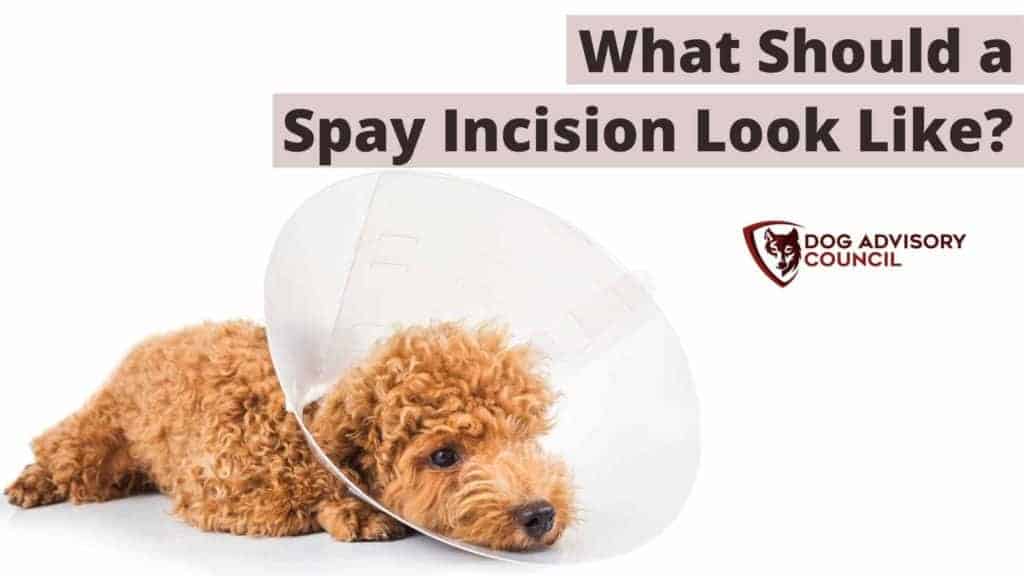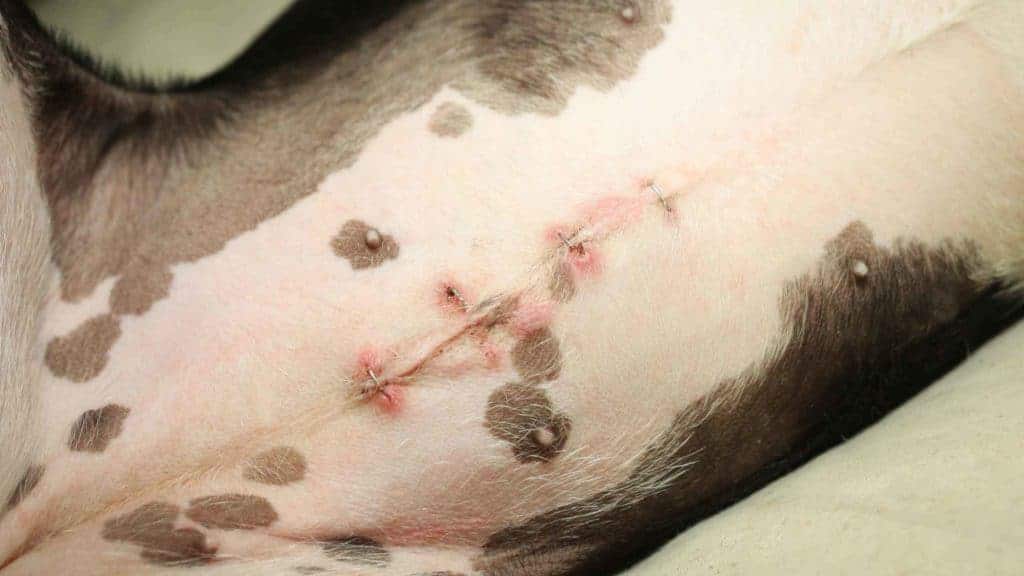
As any concerned pet parent, you’ll want to ensure that your dog’s spay surgery incision is healing properly, right? Below are all of the good and potentially bad signs to watch for.
If a spay incision is healing properly, you will see a straight line on your dog’s shaved stomach with raised edges that are butted together (and sutured). There will be mild swelling, causing the incision to appear raised, and perhaps light bruising in the areas around the swelling. Some incisions may have slight clear or pinkish discharge in the first few days of healing.
What should a spay incision look like after a week?
Every dog is going to heal a little differently, of course, but the healing time for a spay is pretty standard. After a week, the spay incision will have lost most, if not all, of its redness. The swelling will be minimal along the incision line itself. It’ll appear as though the incision is simply disappearing!
How do I know if my dog’s incision is infected?
Both vets and pet parents agree that infection is one of the most common problems when your dog is recovering from her spay surgery. The signs of possible infection of a spay surgery fall into a few categories:
- Change in color of the incision
- Swelling and heat
- Smell and discharge
- Your dog’s discomfort
Unlimited claims, No credit checks, No upper age limit & Multiple pet discounts
Compare the best rates on pet insurance
Change in color of the incision
As the incision heals, it will go from “angry” red to light red, to pink, to skin-colored. Inflammation is totally normal, of course, since it’s the body’s response to trauma, and it is working to heal it. Swelling is considered a good thing, initially!
If the swelling of the incision is going the other way, however, it could be a sign of an infection. If it fades from red to pink but then goes back to red, something hash appended to irritate the incision. It could just be chafing or picking at the wound, but it could be an infection.
Similarly, if the swelling just stays at “angry” red and doesn’t fade, this is where you will want to get in touch with your vet to see if something is going on beneath the surface.
Swelling and heat
The redness of the incision, if there is an infection, will often be paired with swelling and heat, as well. The swelling will appear to make the incision (part of it) larger than ever, and there will be a lot of heat discharged from it, which you will be able to feel if you place your hand on it or hover it over the incision site.
While there will be some swelling and heat in the first 24-48 hours, of course, it should be going down and reducing, not the other way, as time goes on.
Smell and discharge
Another sign of infection is the sudden appearance of a distinctive “off” smell and discharge. Firstly, the smell. It can smell like anything, from a sudden “medical” smell to something rotting. If you notice a brand new smell and appears to be coming from the incision site, it is most likely an infection. The smell is the bacteria, not your dog’s skin! A healthy incision should not have a smell at all.
As far as discharge, you’ll notice a particular change. In a healthy incision, you can expect some pinkish (not red, just light pink) discharge that will get less and less as time goes on. There is a problem if the discharge suddenly worsens, turns yellow or green, or dark red.
Your dog’s discomfort
Last but not least, your dog will also be uncomfortable in combination with the above description of the spay incision being infected. Perhaps they’re guarding their incision site more. Or they’re even rolling onto the back to “air it out” instinctively as it heats up and gets itchy and painful. If you notice that they’re restless or just uncomfortable when they were previously healing, okay, you’ll want to have a careful look at the incision to see what’s going on.
How do I keep the spay incision from getting infected?
Avoiding infection is going to be the best approach when it comes to your dog’s healing spay incision, of course. Your vet will give you some great information on doing that, but here are some general tips to help you do even more at home!
Avoid bathing or swimming
The water will introduce bacteria to the sensitive and vulnerable skin that is forming where the incision site is. Avoid bathing and swimming for at least a month after the spay, if not longer. This includes sponge baths unless otherwise directed by your vet.
Keep their sleeping area clean
Most people wash their dog’s bedding a few times per year. You’ll want to wash her bed before her spay and then put some sort of blanket or sheet, etc., over top of it. Every day, or every other day, change that sheet out for a clean one. This will help keep her designated sleeping area clean and fresh, which will help her incision heal.
Check for infection manually
You’ll want to keep a close eye on the incision as it heals. This includes looking at the incision carefully for signs like we mentioned above. The best way, especially if you are nervous about missing something, is to take a photo of the incision every single day at roughly the same time. That way, you can always flick back to the previous photos so that you’ll know whether it’s just your imagination or not.
These are also helpful if your vet has questions later, or you bring her in for a check-up just in case as she heals.
Don’t let her lick her wound
Dogs will instinctively want to lick their wound to “help it heal.” This is a lizard brain behavior. Licking her spay incision can have many complications, including tearing out sutures or stitches and introducing bacteria right to the incision site. You’ll want to make sure that she wears a cone while recovering from her spay to prevent this from happening.

How do you know if your dog ripped their internal stitches after a spay?
After infection, torn or ripped stitches are some of the most common complications after spay surgery. While this could be from licking the wound, the most common cause is being too active. Your dog will need to keep from jumping after her spay for a certain amount of time for this reason!
Signs of ripped stitches include bloody discharge or deep purple bruising around the incision line (for internal stitches ripping). External stitch tearing will look like a gap or a hole in their obvious incision line.
In some cases, internal tissue might be poking through that hole, but this is typically only in situations where many stitches have ripped and created a generous-sized hole. Ripped stitches can be severe complications, so you’ll want to bring her to the vet if you notice that she is missing even one or two.
When a dog gets spayed, do the stitches dissolve?
Yes, modern-day spay procedures have sutures and stitches that will dissolve after about one week. She will not need to return to the vet to have them removed. You will start to see them dissolve from the weakest point first (the middle, typically), with the ends where a knot is the last to dissolve.
Occasionally, you’ll notice an increase in clear, pinkish discharge when this happens. You’ll want to keep a close eye for the wound ripping open since it can happen in some cases if the sutures dissolve (automatically) before the wound is sealed.
Is it okay for my dog to lie on her stitches?
Some dogs will intentionally guard their stitches as they recover for the first few days, and others will deliberately lay on their backs to “expose them” as they struggle with discomfort.
If your dog wants to lie on her stitches, this is okay. But you’ll want to make sure that she isn’t chafing them on anything that may cause her irritation, infection, or ripping them open. If you can get her to lie on her side, this is the best option.
Is it normal for my dog’s spay incision to leak?
Mild clear or slightly pink discharge leakage is normal after a spay, especially in the first 1-3 days. This will taper off as the incision heals and the skin starts to close at the line of the incision.
How do I know if my dog’s spay incision is fully healed?
There are a few relatively simple ways for you to know if the incision is healed entirely. The first would be time, of course. Typically, a spay will heal in 10-14 days.
However, there are other easier signs to watch for as far as “actual” healing versus “supposed” healing. These include:
- No pain or tenderness on the incision site
- The incision is disappearing on the skin
- Your dog no longer wants to lick/pick at her incision
These all indicate that she is feeling more like herself again. Also, more importantly, her incision is healing without complications!
All in all
A healthy and healing spay incision will be a straight line on your dog’s stomach with raised edges and visible stitching or invisible suturing holding the raw edges together.
There will be slight redness and swelling, slight bruising, and perhaps light pink or clear discharge as the wound heals.
It’s essential to know the signs of infection or ripped stitches, however, for proper care!
A dog’s spay incision will look slightly different from one dog to another, but it should look like a straight line on her shaved tummy with slight swelling.
Is someone in your life worried about their dog recovering from a spay? Share this article with them to help them find helpful information!
Unlimited claims, No credit checks, No upper age limit & Multiple pet discounts
